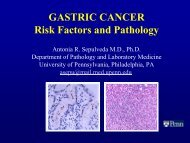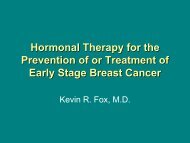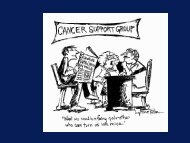Life After Allogeneic Stem Cell Transplantation Leukemia And
Life After Allogeneic Stem Cell Transplantation Leukemia And
Life After Allogeneic Stem Cell Transplantation Leukemia And
Create successful ePaper yourself
Turn your PDF publications into a flip-book with our unique Google optimized e-Paper software.
<strong>Life</strong> <strong>After</strong> <strong>Allogeneic</strong> <strong>Stem</strong> <strong>Cell</strong><strong>Transplantation</strong><strong>Leukemia</strong> and Lymphoma SocietyNovember 6, 2009Noelle Frey, MDAssistant Professor of MedicineUniversity of PennsylvaniaJacqueline Smith, MSN; CRNP; AOCNPCoordinator <strong>Allogeneic</strong> Transplant ProgramUniversity of Pennsylvania
<strong>Allogeneic</strong> <strong>Stem</strong> <strong>Cell</strong><strong>Transplantation</strong>GOAL=CURE
<strong>Allogeneic</strong> <strong>Stem</strong> <strong>Cell</strong><strong>Transplantation</strong>Cures Disease in Two Ways:1. Intensive chemotherapy and/or radiation– More therapy is better– Receiving stem cells makes “safe”2. New Immune system from the donor– Graft versus tumor effect– Graft versus host disease– Medications to weaken immune sytem– Infections
<strong>Allogeneic</strong> Bone Marrow <strong>Transplantation</strong>•High dose chemotherapy + XRT :–Anti-tumor effects, immunosuppression,myeloablation• Replace with normal donor hematopoietic cells.CondRxAlloBMTTXTRecipient Blood<strong>And</strong> <strong>Leukemia</strong>TDonorBlood <strong>Cell</strong>s
<strong>Allogeneic</strong> SCT:Side Effects and ComplicationsHigh Dose Therapy• Infections: short term• Heart & Lung Problems• Infertility• NeurocognitiveDonor Immune System• Infections: short termand long term• GVHD• Graft FailureOther•Relapse•Graft Failure•Psychological
Phases of <strong>Life</strong> <strong>After</strong> Transplant• 2-6 Months Post Transplant:The Immediatepost-transplant phase– Weekly visits– Common readmission– Frequent testing• 4-12 Months Post Transplant: The “I should befeeling better but…” phase– Visits space out– Complications possible but less common• 1 or 2 years and longer Post Transplant: Thelong-term follow-up phase
The Immediate post-transplanttransplantphase (2-6 6 months)• Frequent visits and blood tests• Assess symptoms– Infections (fevers, cough, diarrhea, urinary problems)– Graft-vs-host disease• Rash, diarrhea, nausea, loss of appetite– Sleeping, appetite, fatigue and activity, etc…• Adjust medications– GVHD prophylaxis or therapy (cyclosporine,tacrolimus, steroids, other)– Antibiotics (typically 1-3 different medications)– Blood pressure– Magnesium, potassium and other electrolytes
Common medications in earlypost-transplant transplant phase• Adjust medications– Tacrolimus– Cyclosporine– Prednisone– <strong>Cell</strong>cept– Bactrim or Dapsone– Fluconazole or voriconazole– Acyclovir– Magnesium– Potassium– Blood pressure pills– Sleeping medication– Anti-anxiety therapy (Ativan, etc…)– Anti-depressant– Vitamins• Issues– Too many– Complicated– Too big– Side effects
The “I I should be feeling better but…”phase (4-12 months)• Visits space out to every 4-12 weeks– Blood tests– Assessments for GVHD, infection, diseaserecurrence• GVHD a major issue• Other complications possible but lesscommon• Beginning to be more active and return to“life” a major focus.
The Long Term Follow Up Phase:1-22 Years and More after SCT• Visits with Oncologist REALLY space out– Quite Variable depending on need– Please stay in touch• Care shared with primary physician,cardiologist, gynecologist, endocrinologist etc.• Relapse and GVHD become less frequent• Risks of secondary cancers• Return to “life” a major focus.
DONORHOSTGVHSkinGut
Graft-vsvs-Host Disease• Donor immune cells (graft) recognize thepatient’s cells (host) as foreign.• Acute (early) GVHD typically in first 100 days• Chronic (late) GVHD after 100 days and up toseveral years after BMT• Can occur in 30-70% of patients• May be triggered by infection, sunburn.– Dry eyes, dry mouth, skin rashes and tightness,trouble swallowing, eating, vaginal dryness andstrictures, lung damage, weight loss, infections.
Acute Graft-vsvs-Host Disease• Skin:– Mild rash– blistering and desquamation• Liver:– cholestasis; mild to severe liver failure• GI:– cramps, anorexia, diarrhea• Anywhere: (Lung, Eye,Joints)
ChronicGraft-vsvs-hostdiseaseTypically more than 100days after BMT
Chronic GVHD• Mucous membranes– Dry eyes– Dry mouth– Vaginal dryness and strictures• Skin– Hypo or hyperpigmentation (dark and light spots)– Loss of hair– Thickening– Tightness• Joint contractures limiting mobility• Muscle wasting• Weight loss (“wasting syndrome”)
GVHD: TREATMENT• Treatment– Immune suppression with steroids and othermedications• Often long term• 80% of all patients ultimately off therapy.• Side effects from medications often as bad as GVHD.– Muscle wasting and weakness (steroid myopathy)– Increased risk of infection– Other– Ophthalmology, dental evaluations as needed– Physical therapy!!– Exercise
<strong>Allogeneic</strong> SCT: Infections• Highest risk in first year or with GVHD• Bacterial– Risk with neutropenia– Risk with Central lines– Vaccinate!• PCP: Pneumocystis– Prophylaxis: Bactrim or Dapsone• Fungal:– Prophylaxis with fluconazole or voriconazole– Risk with neutropenia, steroids and GVH• Viral– CMV: blood work to screen for early infection/re-activation– VZV (chickenpox, “shingles”) & HSV: Acyclovir prophylaxis– Flu; H1N1: Vaccinate!
<strong>Allogeneic</strong> SCT:Prevention of Infections• Most patients will take prophylactic antibiotics for3-12 mo and during GVHD.• Vaccinations (at least 12 and 24 mo)– Flu, pneumovax, Hib, diptheria, tetanus– 2 yr add MMR– Hepatitis if high risk– Yearly flu shot• Wash hands• Common sense!!
Butdon’tcarry ittoo far!
<strong>Allogeneic</strong> SCT: Relapse• Risk of relapse decreases with time• Risk of relapse is dependent on type of disease• TREATMENT: DLI: Donor Leukocyte Infusion– Used (either with or without chemo) to invokeGraft vs Tumor response with goal of cure• Clinical Trials:– New medications and chemotherapy drugs– New ways to make DLI more effective
Second cancers• Definition: biologically distinct cancer developing afterthe first• Second cancers are of two types: leukemia/MDS andsolid tumors• <strong>Leukemia</strong>s usually occur within the first few years, solidtumors usually much later• When you look at adult survivors, risk is modest 1.3-1.7xgeneral population• Among children survivors, risk is higher but when youlook at all survivors over time the individual risk per yearis rather small; standard screening for ‘screenable’tumors is usually started earlier.
<strong>Allogeneic</strong> SCT: HeartComplications• Heart Failure: “Pump not working as well”– much less common now with attention to chemo doses andradiation fields– Usually within 1- 5 years; later complications rare• Prevention: other comorbid conditions remainimportant (obesity, blood pressure, etc)• Difficult to establish benefit of antioxidants, vitamintherapy in humans• Follow –up heart studies are very common in patientswith prior anthracyclines +/- radiation to the chest
<strong>Allogeneic</strong> SCT: HeartComplications• Pericarditis (inflammation of the outer lining ofthe heart)-– rare; associated more with prior radiation thanchemo and is usually rather delayed (>10 years)• Possible higher incidence of heart attacksfrom coronary artery disease; associatedmore with radiation exposure.– Has not been shown to be largely increasedcompared to the general population
<strong>Life</strong> after Transplant: Long term care• Infections– If chronic GVHD or on steroids– Vaccinate• Fatigue– Physical therapy and exercise• Oral complications– Increased risk caries, dry mouth, mouth sores– Dental evaluation at 6-12 mo, annually, and as needed• Eyes– Dry eyes– Cataracts– Routine exams at 1 year and annually• Hypothyroidism (~25%) in ~25%– Thyroid testing yearly or as needed• Respiratory– Possible long term damage. Assess as needed.
<strong>Life</strong> after Transplant• Muscles and joints– Osteoporosis particularly with long term steroid use.– Avascular necrosis (permanent damage ) to joints– Muscle weakness particularly with steroids• Sexual dysfunction– Psychological and physical– Discuss with caregivers– Hormonal testing and replacement as needed– Common sense• Premature menopause and infertility– Most patients– Not a method of birth control– Yearly exams and testing as needed• Quality of life and psychosocial adjustment
<strong>Life</strong> after Transplant• Quality of life and psychosocial adjustment– Chronic fatigue– Anxiety• Relapse• Other cancers– Concentration– Job loss– Changes in personal relationships• Discuss with– Medical care team– Professional counseling– Support groups– Other patients– <strong>And</strong> remember…
Depression and Anxiety• A certain level of depression or anxiety arenormal and expected.• Ongoing high levels of psychologicaldistress should be treated aggressively• Seek support from family, friends andprofessionals (social work, physicians,psychologists)
How Do I Cope?• Everyone is different and different copingstrategies work differently for everyone• Reduce as many stressors as possible• You are more than your illness• Talking helps: Can relieve distress and helpintegrate your trauma into your life• Engage in activities that you enjoy/newactivities• Set short term goals
Managing Relationships withFriends and Family“An Individual Doesn’t Get Cancer,A Family Does”( Terry Tempest Williams)
Conclusion• “The diagnosis of cancer creates a sense of urgency about timethat goes along with the uncertainty it causes. However, theperson who can say “I’m just going to take one day at a time” isable to stay focused on the tasks of that day. The person whohardly enjoys today because of concerns and worries abouttomorrow has a much harder time dealing with illness….Hard asit is to keep thinking that way, coping with cancer is easier if youtry not to focus on all the challenges that may lie ahead, butrather, stay focused on today, during which you can accomplishsomething despite the problems caused by the treatment.” (Dr.Jimmie Holland, 2000)
Resources<strong>Leukemia</strong> & Lymphoma Society www.lls.org or 1-800-482-2873National Marrow Donor Program- Office of PatientAdvocacy www.marrow.org or 1-888-999-6743National Bone Marrow Transplant Linkwww.nmbtlink.org or 1-800-546-5268Onco Link www.oncolink.upenn.edu




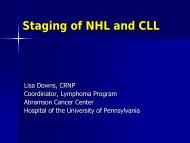
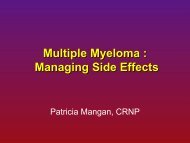

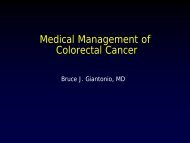
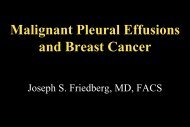
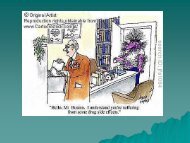
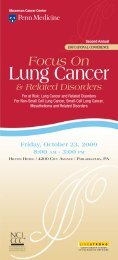
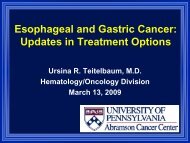
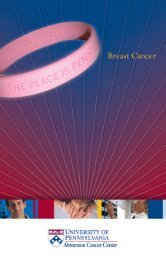
![Agenda [PDF] - Abramson Cancer Center](https://img.yumpu.com/35341208/1/190x245/agenda-pdf-abramson-cancer-center.jpg?quality=85)
